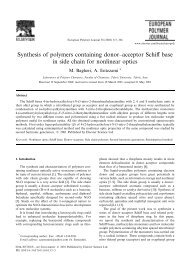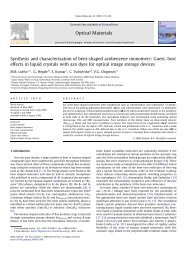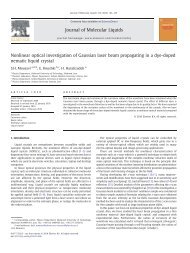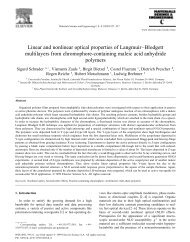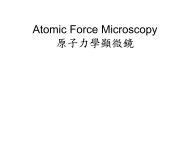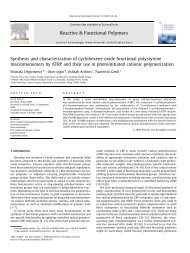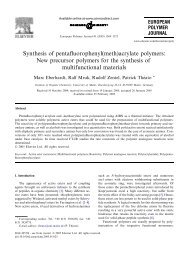Photosensitive polymers with cinnamate units in the side position of ...
Photosensitive polymers with cinnamate units in the side position of ...
Photosensitive polymers with cinnamate units in the side position of ...
You also want an ePaper? Increase the reach of your titles
YUMPU automatically turns print PDFs into web optimized ePapers that Google loves.
2396 R. Mahy et al. / European Polymer Journal 42 (2006) 2389–2397<br />
Ultraviolet lamp. IR and UV spectra <strong>of</strong> <strong>the</strong> copolymer<br />
6b recorded after various times <strong>of</strong> irradiation<br />
are given <strong>in</strong> Fig. 7. The UV analyses show that<br />
<strong>the</strong> <strong>in</strong>tensity <strong>of</strong> absorbance at k = 310 nm due to<br />
<strong>c<strong>in</strong>namate</strong> moieties decreases dur<strong>in</strong>g exposure.<br />
While that at k = 260 nm due to <strong>the</strong> cyclobutane<br />
formation <strong>in</strong>creases gradually. The <strong>in</strong>solubility <strong>of</strong><br />
<strong>the</strong> studied films <strong>in</strong> organic solvents after <strong>the</strong> irradiation<br />
confirms that photocrossl<strong>in</strong>k<strong>in</strong>g took place. In<br />
IR analysis, <strong>the</strong> decrease <strong>of</strong> C@C absorption band<br />
at 1613 cm 1 upon irradiation was assigned to <strong>the</strong><br />
cyclobutane formation by dimerization <strong>of</strong> C@C <strong>c<strong>in</strong>namate</strong><br />
groups.<br />
More detailed studies on <strong>the</strong> ability <strong>of</strong> homopolymer<br />
5 and co<strong>polymers</strong> 6 to crossl<strong>in</strong>k under UV<br />
irradiation are under <strong>in</strong>vestigation. The results <strong>of</strong><br />
<strong>the</strong>se studies will be reported elsewhere.<br />
4. Conclusion<br />
Absorbance<br />
a b<br />
1.0<br />
0.8<br />
0.6<br />
0.4<br />
200 300 400 500<br />
Wavelength<br />
- 0 m<strong>in</strong><br />
- 10 m<strong>in</strong><br />
- 30 m<strong>in</strong><br />
- 50 m<strong>in</strong><br />
- 75 m<strong>in</strong><br />
- 115 m<strong>in</strong><br />
<strong>Photosensitive</strong> <strong>polymers</strong> <strong>with</strong> <strong>c<strong>in</strong>namate</strong> <strong>units</strong><br />
<strong>in</strong> <strong>side</strong> <strong>position</strong> <strong>of</strong> cha<strong>in</strong>s were prepared by homopolymerization<br />
and copolymerization <strong>of</strong> ethyl acyano-4-(methacryloxy)<strong>c<strong>in</strong>namate</strong><br />
<strong>with</strong> methyl<br />
methacrylate. Homopolymerization and copolymerizations<br />
were carried out at 65 °C <strong>in</strong> chlor<strong>of</strong>orm.<br />
The structures <strong>of</strong> <strong>the</strong> formed <strong>polymers</strong> were characterized<br />
by IR and 1 H NMR. Homo- and co-<strong>polymers</strong><br />
<strong>of</strong> medium molecular weights were obta<strong>in</strong>ed<br />
<strong>with</strong> good yields (60–95%). They were easily soluble<br />
<strong>in</strong> most <strong>of</strong> <strong>the</strong> organic solvents such as butanone,<br />
THF, CH 2Cl 2, CHCl 3, benzene, toluene, DMF<br />
and dioxane.<br />
Absorbance<br />
0.4<br />
0.3<br />
0.2<br />
0.1<br />
0.0<br />
- 210 m<strong>in</strong><br />
- 170 m<strong>in</strong><br />
- 110 m<strong>in</strong><br />
- 55 m<strong>in</strong><br />
- 15 m<strong>in</strong><br />
- 0 m<strong>in</strong><br />
1600 1650 1700 1750<br />
K<strong>in</strong>etic studies <strong>of</strong> homo- and co-polymerization<br />
were performed <strong>in</strong> deuterated chlor<strong>of</strong>orm under<br />
nitrogen atmosphere. In <strong>the</strong> case <strong>of</strong> <strong>the</strong> homopolymerization<br />
<strong>of</strong> 4, <strong>the</strong> plot <strong>of</strong> Ln(M0/Mt) versus<br />
[1 exp( kd Æ t/2)] leads to a kp= ffiffiffiffi p<br />
kt ratio value <strong>of</strong><br />
0.04 mol 1/2 l 1/2 s 1/2. By compar<strong>in</strong>g <strong>with</strong> that<br />
determ<strong>in</strong>ed for MMA (kp= ffiffiffiffi p<br />
kt ¼ 0:12), it was<br />
deduced that 4 is about three times less reactive than<br />
MMA. This difference <strong>of</strong> reactivity between 4 and<br />
MMA can be expla<strong>in</strong>ed both by steric h<strong>in</strong>drance<br />
and radical resonance stabilization <strong>of</strong> c<strong>in</strong>amate unit.<br />
The lower reactivity <strong>of</strong> 4 compared <strong>with</strong> that <strong>of</strong><br />
MMA was confirmed by <strong>the</strong> results <strong>of</strong> copolymerizations<br />
performed between 4 and MMA, more<br />
especially by reactivity ratios <strong>of</strong> 4 (r1 = 0.08) and<br />
MMA (r2 = 2.8) determ<strong>in</strong>ed from <strong>the</strong> F<strong>in</strong>neman–<br />
Ross method.<br />
A first test <strong>of</strong> photoreactivity performed <strong>with</strong> 6b<br />
showed that <strong>the</strong> syn<strong>the</strong>sized <strong>polymers</strong> can crossl<strong>in</strong>k<br />
<strong>in</strong> <strong>the</strong> solid state when <strong>the</strong>y are exposed to UV<br />
irradiation.<br />
The <strong>in</strong>solubility <strong>of</strong> <strong>the</strong> film at <strong>the</strong> end <strong>of</strong> <strong>the</strong> exposure<br />
to UV irradiation and <strong>the</strong> disappearance <strong>of</strong> <strong>the</strong><br />
UV absorbance at k = 310 nm characteristic <strong>of</strong> <strong>the</strong><br />
<strong>c<strong>in</strong>namate</strong> functions, are significant that crossl<strong>in</strong>k<strong>in</strong>g<br />
occurred probably accord<strong>in</strong>g to a mechanism<br />
similar to that found for <strong>c<strong>in</strong>namate</strong> acid and its<br />
derivatives [17].<br />
Acknowledgement<br />
Wavelength<br />
Fig. 7. UV and IR spectra <strong>of</strong> copolymer 6b (f = 0.3) recorded after each exposure <strong>in</strong>terval.<br />
The authors thank <strong>the</strong> ‘‘Comité Mixte Franco-<br />
Maroca<strong>in</strong>’’ for its f<strong>in</strong>ancial support through <strong>the</strong>



